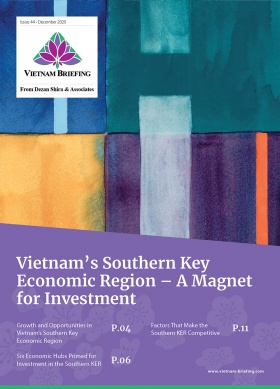Vietnam’s Solar Industry: Bright Prospects for Investors
- Vietnam’s energy consumption will continue to grow as the economy recovers from the pandemic-induced downturn.
- Tight deadlines will make it difficult for investors to benefit from revised feed-in-tariffs, but new investment mechanisms are being considered.
- Other challenges regarding infrastructure and administrative processes need to be addressed to fully take advantage of Vietnam’s solar energy potential.
Vietnam’s golden era for solar development
In June 2020, Sharp Energy Solutions Corporation (SESJ) completed a mega solar power plant in Ninh Thuan province, which is expected to generate 76,373-megawatt hour (MWh) per year. The plant is the newest addition to SESJ’s five other existing solar power plants in Vietnam.
Sharp is only one of the many companies that cashed in on Vietnam’s hunger for renewable power by investing in large-scale solar power projects. As the country bounces back from the pandemic-induced downturn, its energy demand is expected to rise by over 10 percent per year by the end of 2020 and by 8 percent per year in the next decade.
For years, Vietnam like many other developing countries relied on coal as the cheapest and easiest option to meet energy needs. However, technological progress and growing environmental concerns have made renewable energies more attractive. In 2017, solar energy played almost no part in Vietnam’s energy strategy. By the end of 2019, Vietnam surpassed Malaysia and Thailand to reach the largest installed capacity of solar panels in Southeast Asia. The country found itself with 5 gigawatts (GW) of photovoltaic projects, far exceeding the 1 GW by 2020 target.
The following article takes a look at Vietnam’s recent solar boom and the future trajectory of solar energy development in the country.
New FiT approved in the midst of uncertainty
Much of Vietnam’s recent success with solar energy can be attributed to feed-in-tariffs (FiT). FiTs encourage investment in renewable energy by guaranteeing an above-market price for producers. Since they usually involve long-term contracts, FITs help mitigate the risks inherent in renewable energy production.
In April 2020, the Vietnamese government finalized the new solar FiTs, ten months after the previous FiT program expired in June 2019. The new tariffs are 10-24 percent lower than before and are still uniform across regions but differentiated by type (ground-mounted, floating, and rooftop).
Under the new decision, solar projects are required to achieve commercial operation by December 31, 2020, to benefit from the new FiT rates. The delay in the government’s approval gives solar developers a very narrow time frame to work with.
With the current supply chain disruptions affecting solar cells and module delivery from China, and other pandemic-induced economic uncertainties, it will be very challenging for firms to become operational before the deadline. Thus, advisory firms like FitchSolutions expect that the new FiT scheme will not be the main driver of investments in solar energy in Vietnam.
Looking forward, Vietnam still intends to implement an auction mechanism in the future. All projects who do not qualify for the new FIT rates will go through a competitive bidding process. By giving the government the ability to issue a call for tenders and select the most price-competitive firms, the scheme will help better manage clean energy development across the country.
However, a transition away from a FiT scheme may take longer than expected given that undeveloped large-scale photovoltaic projects were just approved to receive tariffs. Attracting investment will largely depend on the government’s ability to deliver a clear auction scheme and other incentives on time.
Long-term commitment to boost solar energy
The revised FiT came shortly after the Vietnamese government announced that it intends to double its power generation capacity over the next decade. This will increase the proportion of renewable energy to 20 percent in an attempt to reduce reliance on coal for electricity production.
In late 2019, the Prime Minister approved the outline of the national Power Development Plan (PDP) VIII, expected to be completed before the end of the year. The PDP VIII covers the period of 2021 to 2030 with a vision to 2045 and sets out renewable energy development and investment attraction as two of the key priorities.
In addition to developing the PDP VIII, the MOIT also submitted Proposal No.544/TTr-BCT on January 21, 2020, which outlines a pilot program on direct power purchase agreement (DPPA) mechanisms.
The DPPA program would allow energy producers to sell and deliver electricity to corporate consumers instead of going through a state-owned electric utility company. The proposal sets a two-year timeframe for implementing the pilot program and lays out the criteria for participating developers and private power consumers. It is expected to range between 400-1000 megawatts (MW) and will be available nationwide.
Despite some criticism of the DPPA’s limited scope, the proposal is a positive development for the growth of renewables in Vietnam. It signals that Vietnam is a serious solar player that is willing to implement support mechanisms to retain investor interest in the renewable energy sector.
Investors will have to contend with other challenges
Beyond the uncertainties over future investment schemes, there are other factors that both investors and government authorities need to consider as Vietnam moves forward with solar energy development.
First, there are some infrastructure shortcomings that hinder energy transmission. Most solar power plants are concentrated in the sunny southern region, where they tend to overwhelm the national grid. Meanwhile, some solar plants have seen their operation date delayed due to incomplete transmission lines.
Bringing energy to economic centers and northern cities is, therefore, still a challenge. The new PDP aims to address this by ensuring that energy development is balanced among the regions, and that power grids are connected within Vietnam and with neighboring countries as well.
Further, ground-mounted solar projects need to consider land rights, an issue that looms large in Vietnam. Though investors can benefit from exemptions from land-use fees and rents, administrative processes can take time and cause significant delays.
There are still uncertainties regarding the future of coal. While the PDP VIII emphasizes sustainable development to address climate change, Vietnam’s coal imports in the first half of 2020 surged by 53.8 percent from a year earlier, a record high. According to the MOIT, coal-fired plants account for around 35 percent of Vietnam’s power generation capacity.
The ministry expects that the country will face severe power shortages as the construction of new power plans fall behind the fast-growing demand for energy. Thus, coal may continue to fill the energy gap in the upcoming years.
However, there are signs of dwindling interest in coal. The majority of planned coal power capacity has been delayed or postponed. Though alleged corruption and engineering difficulties partly explain these delays, local opposition and a global movement away from coal power are also major contributing factors.
For example, South Korean and Japanese lenders have pulled back their investment in coal power projects, while Chinese companies are becoming more aware of the risks of continuing to invest in coal. With proper strategic planning and increased support for investment, Vietnam can leverage the opportunities provided by the solar boom and cement its position as a renewables leader in Southeast Asia.
About Us
ASEAN Briefing is produced by Dezan Shira & Associates. The firm assists foreign investors throughout Asia and maintains offices throughout ASEAN, including in Singapore, Hanoi, Ho Chi Minh City, and Da Nang in Vietnam, Munich, and Esen in Germany, Boston, and Salt Lake City in the United States, Milan, Conegliano, and Udine in Italy, in addition to Jakarta, and Batam in Indonesia. We also have partner firms in Malaysia, Bangladesh, the Philippines, and Thailand as well as our practices in China and India. Please contact us at asia@dezshira.com or visit our website at www.dezshira.com.







